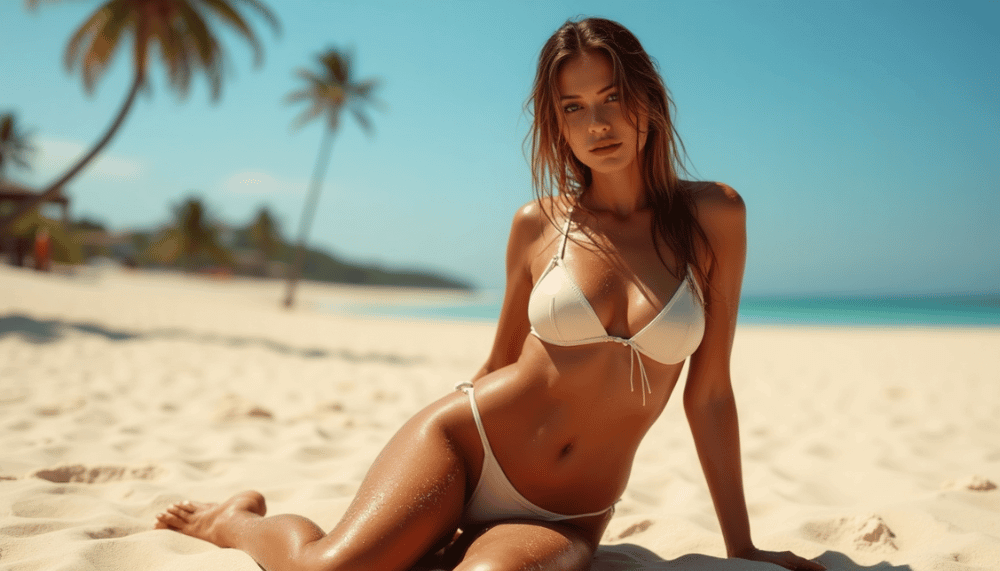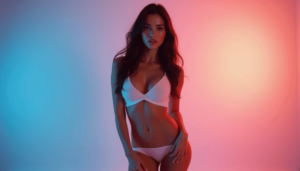Let’s start with a simple cotton T-shirt. You’ve probably worn dozens in your life. But did you know each one requires nearly 2,700 liters of water to make? That’s the amount a person would drink over three years. For one shirt. Now multiply that by the billions produced each year. Feeling a little parched yet?
The fashion industry—glamorous, fast-moving, seductive—has a secret. Or maybe it’s not so secret anymore. Beneath the shimmer of runway lights and influencer reels lies a much heavier truth: environmental degradation, labor exploitation, and an endless churn of waste. It’s beautiful on the surface, but brutal behind the scenes.
Still, something is changing. 🌿
Not in grand headlines or sweeping reforms (yet), but in the quiet corners of the industry. In the smaller rooms. In the niche modeling agencies that have decided they’re done with business as usual. These agencies aren’t just booking gigs—they’re building movements. Ethical, sustainable, transparent ones.
They’re proving that fashion can be artful and accountable. That beauty doesn’t have to come at the cost of the planet—or the people who make the clothes.
Why Fashion Can’t Keep Pretending 📈
Fashion is a global beast. It generates over $1.3 trillion a year. It employs millions. It influences everything from music videos to boardroom aesthetics. But it also consumes natural resources like it has an unlimited tab.
Let’s break it down—not just with stats, but with scale.
The Environmental Toll
- Water: One pair of jeans? About 7,500 liters. That’s what one person would drink in seven years. Add to that the toxic runoff from dyeing fabric, and you’re looking at a major polluter—contributing up to 20% of global water contamination.
- Carbon: The fashion industry pumps out more carbon emissions than all international flights and maritime shipping combined. Let that land. All those jet engines and cargo ships? Fashion beats them.
- Waste: We discard about 92 million tons of textiles a year. That’s one garbage truck of clothes every single second. Most of it? Barely worn. Some of it? Never worn at all.
- Fast Fashion: The industry thrives on speed—24 new collections a year from some brands. The result? Clothing becomes disposable. Quality nosedives. Landfills overflow.
The Human Cost 💲💲
And then there’s the part we don’t see on tags or in lookbooks: the workers. Mostly women. Mostly in the Global South. Many making less than $3 a day in factories that cut corners on safety and dignity.
Remember the 2013 Rana Plaza collapse in Bangladesh? Over 1,100 people died making clothes for the global market. And we still haven’t learned enough.
As if that weren’t enough, the industry’s inclusivity problem continues to fester. Diversity, when it shows up, often feels like a checkbox—not a change of heart.
Clearly, fashion needs more than a seasonal refresh. It needs a reckoning. And that reckoning is coming from some unexpected places.
Enter: Niche Modeling Agencies with a Mission 🔥
Not all agencies are playing by the old rules. In fact, a handful have thrown the rulebook out entirely.
These boutique modeling agencies aren’t chasing fame or fast cash. They’re small, yes—but fiercely intentional. Their mission is simple: raise the bar. Do better. Work with brands that aren’t poisoning rivers or underpaying workers. Represent models who care about more than angles and lighting.
They’re not interested in performative sustainability. They want the real thing.
What Sets These Agencies Apart?
Let’s get specific.
- Value-Driven Operations: Their ethos is rooted in sustainability—not just as a buzzword, but as a foundation. They consider the environmental impact of everything, including their own office space, travel, even the partners they choose.
- Carefully Chosen Models: They don’t just represent faces. They represent voices. Activists. Educators. People who walk the walk, not just wear the brand.
- Ethical Brand Collaborations: They’re selective. Aesthetics matter, yes—but ethics are non-negotiable. If a brand can’t trace its supply chain or respect fair wages? It’s a no.
- Radical Transparency: These agencies demand accountability—from their partners, from their clients, and even from themselves. No greenwashing. No fluff.
A New Kind of Model: Bold, Smart, and Purposeful 🚀
These models aren’t just walking the runway—they’re walking the talk. Here’s what makes them different.
- Eco-Conscious Advocacy: Take Nerida Lennon, for example—an Australian model who refuses to work with brands that aren’t sustainable. Her portfolio is a statement in itself.
- Real Representation: Non-binary models. Plus-size models. Older models. Models of color. Not as exceptions, but as the norm. Finally.
- Platform Power: These models don’t just show up for the camera—they speak up online, using their platforms to educate, inspire, and occasionally, call out hypocrisy.
Behind the Scenes: Sustainable Practices You Don’t Always See
Even the agency infrastructure is being reimagined.
- Green Operations: Offices use renewable energy. Meetings happen over Zoom, not flights. Paper gets recycled. The basics add up.
- Eco-Friendly Collaborators: They choose photographers, stylists, and caterers who share their values. Because change happens at every level.
- Carbon Offsetting: From planting trees to supporting clean energy, many of these agencies actively neutralize their environmental impact.
Brands That Get It: A New Kind of Partnership
These agencies aren’t going it alone. They’re aligning with brands that care—and pushing others to level up.
- Selective Collaborations: Agencies align only with brands like Stella McCartney or People Tree—companies known for their strong environmental and ethical commitments.
- Consulting and Educating: They don’t just model—they advise. They help brands switch to organic fibers, reduce packaging, and tell better stories.
- Transparency Tools: Think digital product passports—showing where a garment came from, who made it, and how it got to you.
Meet the Disruptors: Agencies That Are Changing the Game
Let’s shine a light on a few trailblazers who aren’t just riding the sustainability wave—they’re shaping it.
1. The Ethical Fashion Initiative (EFI) 🌍
Where they’re based: Global
What they do: Connect artisans in developing countries with major fashion brands.
Why it matters: They’re flipping the script. Instead of seeing artisans in places like Burkina Faso or Haiti as a cheap labor pool, EFI sees them as designers, storytellers, and entrepreneurs.
- Their approach? Slow fashion. Local textiles. Fair pay. Dignity.
- Real-world impact? A line of luxury handbags using recycled materials that cut textile waste by 30%—without compromising on style.
They prove that luxury and sustainability aren’t opposites. They’re just rarely found in the same room—until now.
2. EKOLUV (Australia) 🇦🇺
Founder: Emily Kate Symes—a model turned activist with a mission.
What they do: Represent models who live and breathe slow fashion, and operate an online store offering curated, sustainable accessories and secondhand gems.
- What makes them stand out? Models aren’t just pretty faces—they’re influencers with purpose.
- Viral moment? A campaign with models dressed entirely in upcycled denim exploded on social media. Ten thousand people pledged to shop secondhand for a full year. That’s culture shift, not just clickbait.
3. Good On You 🌟
Not a traditional agency—but close.
They partner with models, creators, and activists to promote sustainable brands through transparent ratings and smart, accessible tools.
- How it works: Their app rates thousands of fashion brands based on ethics, environment, and labor.
- Cultural influence? Their partnership with models in Reformation’s eco-line campaign led to a 15% sales bump in just one month. Proof that informed consumers still want to look good—but they want to feel good, too.
The Ripple Effect: Big Change from Small Players
These niche agencies are small—intentionally so. But don’t mistake “boutique” for “insignificant.” Their impact is outsized.
📈 Raising Industry Standards
Their mere existence pressures mainstream agencies to evolve. H&M, sensing the heat, now boasts its “Conscious Collection.” Is it perfect? No. But the bar is rising.
🎤 Empowering Models as Activists
Modeling used to be about silence and symmetry. Now it’s about voice and values. Think of Summer Rayne Oakes, who only works with ethical brands and uses her platform to fight textile waste. She’s not just a model—she’s a movement.
🛍️ Changing the Way We Shop
Through storytelling, social campaigns, and straight-up truth-telling, these agencies are changing what consumers look for. Secondhand marketplaces like Depop and Vinted are booming. Half of millennials say they’ll buy more preloved clothes this year. That’s not a blip. That’s a shift.
The Roadblocks: What’s Holding This Movement Back?
Let’s be honest. The road to sustainable fashion isn’t lined with organic cotton and good intentions. There are challenges.
⚠️ Scaling Without Selling Out
Growth is hard. The bigger an agency gets, the harder it becomes to stay hands-on and values-driven. The pressure to compromise is constant.
⚠️ Funding the Future
Eco-friendly choices often cost more upfront. Renewable energy, fair wages, low-impact materials—they’re investments. And not all investors are patient.
⚠️ The Greenwashing Trap
The more popular “sustainability” becomes, the more brands try to fake it. Slapping on an “eco” label doesn’t mean a product is ethical. These agencies are on the frontlines of that fight—but the noise is deafening.
What’s Next: A Fashion Future Worth Wearing
The future isn’t fixed. But it’s looking greener than ever.
🌞 Legislation Is Coming
Europe’s EU Strategy for Sustainable Textiles could push real, industry-wide change. Think: legal requirements for transparency, minimum sustainability standards, and tighter controls on waste.
🧠 Consumer Savvy Is Rising
The average shopper is no longer average. People are asking questions. Reading labels. Googling ingredients. Wanting to know the story behind what they wear.
🤝 Collaboration > Competition
Agencies, designers, and even platforms are beginning to realize that no one wins if the planet loses. Shared values are trumping solo egos. Finally.
Want In? Here’s How You Can Be Part of the Change
Whether you’re a model, brand, or consumer, there’s a role for you in this revolution.
For Models 🌟
- Align with your values: Seek agencies like EFI or EKOLUV that walk the talk.
- Curate an eco-conscious portfolio: Show work with ethical brands. Include activism. Be the story.
- Find your community: Join groups like the Sustainable Fashion Forum or Fashion Revolution.
For Brands 🏬
- Vet your partners: Work with agencies that require transparency and ethics, not just aesthetics.
- Be real: Share your supply chain. Publish your progress. No smoke, no mirrors.
- Co-create with purpose: Build campaigns that educate and inspire. Think beyond the photoshoot.
For Shoppers 🛍️
- Buy less, choose better: Prioritize timeless over trendy. Quality over quantity.
- Support ethical labels: Look for certifications like GOTS, Fair Trade, and B Corp.
- Speak up: Ask brands hard questions. Use hashtags like #WhoMadeMyClothes. Your voice matters.
FAQ: Real Talk, Quick Answers
Q: What does “sustainable fashion” really mean?
A: It means protecting the planet and people. Using eco-friendly materials, paying fair wages, and reducing waste. It’s a mindset, not a trend.
Q: Aren’t sustainable clothes expensive?
A: Sometimes, yes—but you get what you pay for. Durable, well-made pieces that last. And secondhand is always budget-friendly.
Q: How do I spot greenwashing?
A: Vague language is a red flag. Look for hard data, transparency reports, and third-party certifications. If it sounds too good—it probably is.
Q: Do my choices really matter?
A: Absolutely. Every purchase is a vote. Enough votes? That’s a movement.
Final Stitch: The Runway Is Turning Green
Fashion doesn’t have to be wasteful. It doesn’t have to be exploitative. It can be beautiful and just. Expressive and responsible.
Niche modeling agencies are proving that change doesn’t require perfection—it requires courage. Their work may start on the runway, but its impact? That ripples into boardrooms, closets, and conversations around the world.
So wear your values. Support the disruptors. Ask more questions. And above all—don’t be afraid to care loudly.
Because fashion should never cost us the future. 💚




